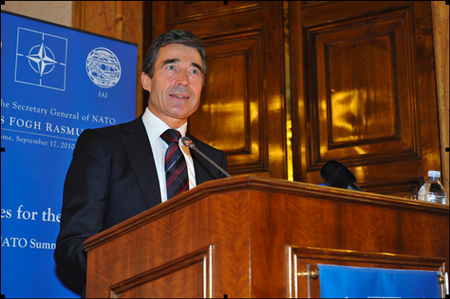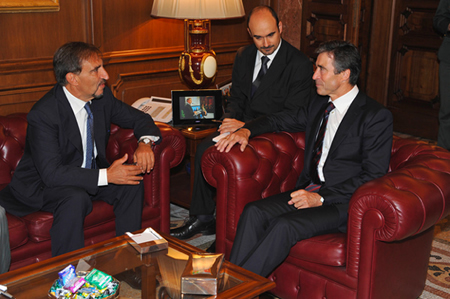Rasmussen: Lay Short-Range Nuclear Weapons Thinking to Rest

By Hans M. Kristensen
The next steps in European security should include additional reductions in the number short-range nuclear weapons in Europe, according to a video statement issued by NATO General Secretary Anders Fogh Rasmussen:
“We also have to make progress sooner or later in our efforts to reduce the number of short-range nuclear weapons in Europe. NATO has cut the number of short-range nuclear weapons in Europe by over 90 percent. But there are still thousands of short-range nuclear weapons left over from the Cold War and most of them are in Russia. NATO is not threatening Russia and Russia is not threatening NATO. Time has come to lay this Cold War thinking to rest and focus on the common threats we face from outside: terrorism, extremism, narcotics, proliferation of missiles, weapons of mass destruction, side by side, and piracy. We can make progress of all three tracks – missile defense, conventional forces, and nuclear weapons – and create a secure Europe. It is time to stop spending our time and resources watching each other and look outward at how to reinforce our common security hope.”
That vision appears similar to the “new regional deterrence architecture” that several recent Obama administration reviews concluded would permit a reduction of the role of nuclear weapons. With that in mind, and Rasmussen’s conclusion that “Russia is not threatening NATO” and that the “time has come to lay this Cold War thinking to rest,” it should be relatively straightforward for him to recommend a withdrawal of the remaining U.S. nuclear weapons from Europe.
Unfortunately, rather than taking the initiative to complete the withdrawal of U.S. short-range nuclear weapons from Europe – a process that have been underway now for two decades but held up by Cold War thinking and NATO bureaucrats, Rasmussen instead appears to weave the future of the weapons in Europe into a web of new conditions that must be met first. In a speech at the Aspen Institute in Rome, Rasmussen described his three-track vision of collaborating with Russia on missile defenses, conventional weapons negotiations, and reducing short-range nuclear weapons:
“I think we have before us three tracks, which, if we follow them, will lead to a different, better and safer Europe: where we don’t look over our shoulders for someone else’s tanks or fighters; where missile defences bind us together, and protect us too; and where steadily, the number of short-range nuclear weapons on the continent is going down.”
Nuclear reductions appear to be the third track, after missile defense collaboration and conventional arms negotiations with Russia. For two decades, NATO has insisted the U.S. nuclear weapons in Europe have no military mission and that they’re not linked to Russia. The alliance has repeatedly been capable of and willing to make unilateral reductions – even complete withdrawal from Greece and the United Kingdom – without conditions or demanding reductions in Russian short-range nuclear weapons.
So why start linking reductions to Russia now?
Doing so seems to turn back the clock to the Cold War when NATO looked to Russia’s military forces to determine its nuclear posture in Europe. If the conclusion that “Russia is not threatening NATO” is more than words, then why make a three-track vision that assumes that Russia’s short-range nuclear weapons threaten NATO? Because the short-range weapons are not covered by any arms control regime, Rasmussen explains, the lack of transparency “makes allies cautious.”
There are certainly many good reasons to want to try to secure and reduce Russian short-range nuclear weapons. But if Russia is not threatening NATO, then Russian and U.S. short-range nuclear weapons should be addressed as a generic arms control challenge and not one that is linked to whether the U.S. has nuclear weapons in Europe or not.
| Did They Lay Cold War Nuclear Thinking to Rest? |
 |
| During his meeting with Italian defense minister Ignazio La Russa, did Rasmussen discuss the possibility of a withdrawal of U.S. nuclear weapons from Europe, including Italy, or just the threat of Russian short-range nuclear weapons? |
.
If NATO unilaterally withdrew the remaining U.S. nuclear weapons from Europe, what would happen?
Would Russia decide that it didn’t have to reduce its short-range nuclear weapons? Hardly, since those forces seem to be more tied to Russia’s perception of NATO’s conventional superiority and a need to safeguard the long border with China. Besides, many of the Russian weapons are so old that they’re likely to be retired soon.
Would Russia get an advantage in a hypothetical crisis with NATO? Hardly, since it would require that Russia ignores NATO’s conventional superiority and U.S., British, and French long-range nuclear forces.
Would Russia decide that it had more freedom to deploy conventional forces on NATO periphery? Hardly, since such decisions seem to be made regardless of U.S. nuclear weapons in Europe.
Would Iran somehow conclude that it could take additional steps acquiring nuclear weapons capability? Hardly, since its security assessment is not affected by whether the U.S. deploys nuclear weapons in Europe and it would still face serious consequences if it developed – certainly if it used – nuclear weapons.
Would Turkey and Eastern European NATO members conclude that NATO’s security guarantee was no longer credible and begin building nuclear weapons? Hardly, since their assurance is much more determined by conventional forces and political relations, and, to the limited extent nuclear forces play any role, the long-range forces of the United States, Britain, and France, would be more than adequate for any realistic scenario. Moreover, any NATO member country that began to develop nuclear weapons would face enormous pressure from the international community and from within NATO itself.
To the extent that some officials in some eastern European NATO countries feel uneasy about the inevitable withdrawal of U.S. short-range nuclear weapons from Europe, the obvious job for the Obama administration and the majority of NATO countries that favor a withdrawal is a concerted effort to educate those officials about the significant conventional and long-range nuclear capabilities that will continue to provide security when the short-range weapons are withdrawn. The revised Strategic Concept to be adopted at the Lisbon Summit in November is expected to reaffirm a role for nuclear weapons in NATO.
Rasmussen would do more for European security if he tried to decouple the future of U.S. nuclear weapons in Europe from the need to reduce and eventually eliminate short-range nuclear weapons in general. Doing so would indeed be to “lay this Cold War thinking to rest.”
This publication was made possible by a grant from Carnegie Corporation of New York and Ploughshares Fund. The statements made and views expressed are solely the responsibility of the author.
This report outlines a framework relying on “Cooperative Technical Means” for effective arms control verification based on remote sensing, avoiding on-site inspections but maintaining a level of transparency that allows for immediate detection of changes in nuclear posture or a significant build-up above agreed limits.
The grant comes from the Carnegie Corporation of New York (CCNY) to investigate, alongside The British American Security Information Council (BASIC), the associated impact on nuclear stability.
Satellite imagery of RAF Lakenheath reveals new construction of a security perimeter around ten protective aircraft shelters in the designated nuclear area, the latest measure in a series of upgrades as the base prepares for the ability to store U.S. nuclear weapons.
It will take consistent leadership and action to navigate the complex dangers in the region and to avoid what many analysts considered to be an increasingly possible outcome, a nuclear conflict in East Asia.